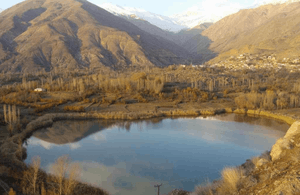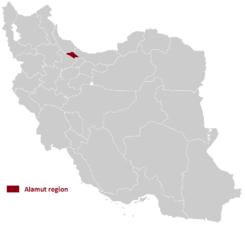Alamut
The Alamut geographic region (Persian: الموت; Alamūt, Alemūt, Alamoot, Alemoot), also Rudbar-i Alamut, is a region in Iran including western and eastern parts in the western edge of the Alborz (Elburz) range, between the dry and barren plain of Qazvin in the south and the densely forested slopes of the Mazandaran province in the north. Starting from Qazvin toward Alamut, passing through the first range of hills, curvatures, forms, are significant themes in nature's composition of this area. Two big citadels of Ismailis, Lambsar and Alamut castles, are in this area. Hassan-i Sabbah and his Assassins controlled the area for many years.[1]
History
In 1090 CE, Hassan-i Sabbah, the leader of the Assassins, a sect of Nizari Ismailis in Iran, chose the Alamut region as his headquarters to campaign, preach and convert new followers. This proved to be a turning point for the destiny of Alamut Valley. The result of over two centuries of Ismailite stronghold, the region witnessed numerous castles throughout, of which at least 20 "castles" dating back to this era have been identified. The most magnificent castle in the Alamut Valley is the Alamut Castle, which is built on top of a high rock reaching 2163 m above sea level near the Gazor Khan Village. The rock is 200 m high and covers an area of 20 hectares (49 acres); with its steep slope and deep and dangerous ravine, the rock is practically inaccessible and forms a part of the fort’s structure. Currently, only ruins of the fort and some towers are apparent, and it is only through archaeological excavation that the main portions can be discovered.[2]
Lords of Alamut Castle who ruled the Nizārī Ismā'īlī state from Alamūt
| The President of Nizārī Ismā'īlī state | Period | Master of Alamūt |
| The First Da'i Hasan bin Sabbah | 1090-1124 | 1. Effendi/Lord |
| The Second Da'i Kiya Buzurg-Ummid | 1124-1138 | 2. Effendi/Lord |
| The Third Da'i Muḥammad ibn Kiyā Buzurg-Ummīd | 1138-1162 | 3. Effendi/Lord |
| 23rd Imām Hasan ‘Alā Dhīkr‘īhī’s-Salām | 1162-1166 | 4. Effendi/Lord |
| 24th Imām Nūr al-Dīn Muhammad | 1166-1210 | 5. Effendi/Lord |
| 25th Imām Jalāl al-Dīn Hasan | 1210-1221 | 6. Effendi/Lord |
| 26th Imām ‘Alā’a-d-Dīn Muḥammad III | 1221-1255 | 7. Effendi/Lord |
| 27th Imām Rukn al-Din Khurshah | 1255-1256 | The state ended |
Today, the leader of the contemporary Ismaili community is the Aga Khan.
 Hir, West Alamut
Hir, West Alamut Ovan Lake, East Alamut
Ovan Lake, East Alamut Alamut fortification in Iran and Ismailites Assassins stronghold
Alamut fortification in Iran and Ismailites Assassins stronghold
Alamut rulers

- Hassan-i Sabbah
- Kia Bozorg Omid
- Muḥammad ibn Kiyā Buzurg-Ummīd
- (in Turkish) El-Hâdî bin el-Nizâr
- (in Turkish) El-Môhtadî bin el-Hâdî (Muḥammad I)
- (in Turkish) El-Kahir bin el-Môhtadî bi-Kuvvet’ûl-Lâh / bi-Ahkâmî’l-Lâh (Hassan I)
- Hasan Alâ Zikrihi’s Selâm
- Nūr al-Dīn Muḥammad II
- Jalaluddin Hasan
- ‘Alā’ ad-Dīn Muḥammad III
- Ruknu-d-Dīn Khurshāh (The last ruler of the Alamut Castle)
See also
- Alamut River
- List of Ismaili castles
- Alamut-e Gharbi District
- Alamut-e Sharqi District
- Alamut-e Bala Rural District
- Alamut-e Pain Rural District
- (in Turkish) Kıyâmet-i Kûbrâ
- Alamut, novel written by Vladimir Bartol in 1938
References
| Wikimedia Commons has media related to Alamut. |

